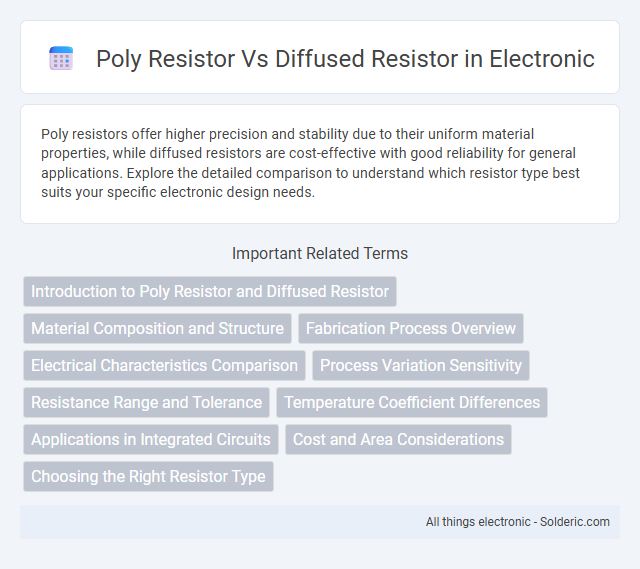Poly resistors offer higher precision and stability due to their uniform material properties, while diffused resistors are cost-effective with good reliability for general applications. Explore the detailed comparison to understand which resistor type best suits your specific electronic design needs.
Comparison Table
| Feature | Poly Resistor | Diffused Resistor |
|---|---|---|
| Definition | Resistor made from polysilicon material deposited on wafer surface. | Resistor formed by diffusing impurities into silicon substrate. |
| Material | Polysilicon film | Doped silicon substrate |
| Resistance Range | Typically higher resistance values (hundreds to kilo-ohms) | Lower resistance values (tens to hundreds of ohms) |
| Temperature Coefficient | Lower temperature coefficient for better stability | Higher temperature coefficient, less stable |
| Noise Performance | Lower noise | Higher noise level |
| Process Complexity | Additional polysilicon deposition step required | Simple doping diffusion process |
| Layout & Size | Compact layout, suitable for higher density integration | Larger area for the same resistance, less density |
| Application | Precision analog circuits, where stability is critical | General-purpose, less critical resistor applications |
Introduction to Poly Resistor and Diffused Resistor
Poly resistors, formed by depositing a thin film of polycrystalline silicon on a substrate, offer high stability and precise resistance values ideal for integrated circuits. Diffused resistors are created by doping a silicon substrate with impurities to modify its electrical properties, providing moderate resistance with good temperature coefficients. Your choice between poly and diffused resistors depends on specific requirements for tolerance, stability, and fabrication process compatibility in semiconductor applications.
Material Composition and Structure
Poly resistors are made from polysilicon, offering a high-density, uniform layer deposited on a silicon substrate, which provides excellent thermal stability and precision. Diffused resistors use a doped semiconductor region diffused into the silicon wafer, resulting in a structure with higher noise and less stability compared to polysilicon. Your choice between poly and diffused resistors can impact circuit performance based on the material composition and structural differences influencing resistance tolerance and temperature coefficient.
Fabrication Process Overview
Poly resistors are fabricated using polysilicon layers deposited on the silicon wafer, then patterned and doped to achieve desired resistance values through ion implantation or diffusion. Diffused resistors are created by diffusing impurities directly into the silicon substrate, controlling resistance by adjusting the dopant concentration and diffusion depth. The polysilicon process offers better stability and higher sheet resistance compared to the diffused method, which tends to have lower sheet resistance and higher temperature coefficients.
Electrical Characteristics Comparison
Poly resistors exhibit stable resistance values with low noise and high frequency performance, making them ideal for precision circuits. Diffused resistors typically have higher temperature coefficients and less stability, resulting in greater variation under thermal stress. Understanding these electrical characteristics helps you choose the best resistor type for reliable and accurate circuit performance.
Process Variation Sensitivity
Poly resistors exhibit higher process variation sensitivity due to their fabrication involving polysilicon layers, which can lead to fluctuations in sheet resistance caused by doping concentration inconsistencies and layer thickness variations. Diffused resistors generally show lower sensitivity to process variations as they are formed by diffusing dopants into the substrate, resulting in more stable and predictable resistance values across manufacturing runs. This makes diffused resistors preferable in applications requiring tight resistance tolerances and improved long-term stability under varying process conditions.
Resistance Range and Tolerance
Poly resistors typically offer a resistance range from a few ohms to several megaohms with a tolerance of +-5% to +-10%, suitable for general-purpose applications. In contrast, diffused resistors generally have a narrower resistance range, often between a few hundred ohms to a few kiloohms, but provide improved tolerance levels around +-1% to +-5%, making them ideal for precision circuits. The choice between poly and diffused resistors depends on the required resistance value and the precision needed in the electronic design.
Temperature Coefficient Differences
Poly resistors exhibit a higher positive temperature coefficient, typically around +100 to +200 ppm/degC, resulting in increased resistance with rising temperature. Diffused resistors offer a lower temperature coefficient, generally ranging between +50 to +150 ppm/degC, providing improved stability over temperature variations. The choice between poly and diffused resistors depends on the specific application requirements for temperature stability and precision.
Applications in Integrated Circuits
Poly resistors are widely used in integrated circuits for precision analog applications due to their stable resistance values and low noise characteristics, making them ideal for signal processing and filtering. Diffused resistors, with their higher temperature coefficients and less precise tolerance, are typically employed in cost-sensitive or less critical areas such as biasing and load resistors within ICs. Understanding the specific requirements of your circuit helps determine the optimal resistor type for performance and reliability.
Cost and Area Considerations
Poly resistors, typically fabricated using doped polysilicon, offer lower cost and smaller die area compared to diffused resistors due to simpler processing steps and higher sheet resistance, enabling compact layout designs. Diffused resistors require additional photolithography and diffusion steps, increasing manufacturing complexity and resulting in larger area consumption on the semiconductor die. Cost efficiency in integrated circuit design often favors poly resistors for high-density applications where minimizing chip area and process expenses is critical.
Choosing the Right Resistor Type
Choosing the right resistor type depends on the specific application requirements, where poly resistors offer high precision and stability suitable for integrated circuits, while diffused resistors provide better noise performance and thermal stability for analog circuits. Poly resistors are typically used in high-frequency and precision applications due to their uniformity and low temperature coefficient, whereas diffused resistors excel in environments with varying temperatures and where low leakage current is critical. Understanding factors like resistance tolerance, temperature coefficient, noise characteristics, and integration level guides engineers to select the optimal resistor type for performance and reliability.
Poly resistor vs Diffused resistor Infographic

 solderic.com
solderic.com